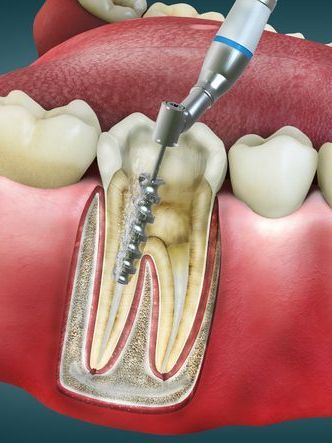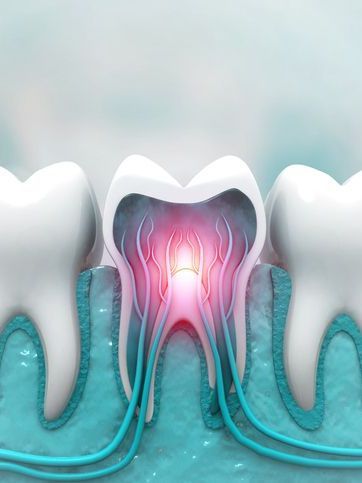
Root Canal Therapy in coral springs, fl
Each year over 14 million root canals are performed in the United States. However, despite being a common dental procedure, it still fills patients with thoughts of pain and anxiety. Fortunately, advances in technology and improved anesthetics have made root canal procedures relatively painless. In fact, many patients receiving root canals report experiencing little to no pain whatsoever during the procedure.
A root canal is an oral procedure that treats infection or damage caused to the pulp tissue (the soft tissue within the tooth) by trauma, severe decay or repeated dental procedures. At Select Dental Care, Coral Springs, FL Dr. Angel is a specialist in gentle, effective root canal treatment that relieves pain, restores tooth function and prevents extraction of your natural tooth.
At Select Dental Care our staff understands the apprehension patients feel about root canals and will work to alleviate their pain, and uneasiness by making them feel more comfortable and confident.
What is a Root Canal
During a Root Canal, Dr. Angel will remove the pulp that is infected, or has been damaged, from the inside of the tooth. He will then clean the canals and seal them to prevent further infection. The tooth is then usually restored with a dental crown in order to maintain its strength and functionality. Contrary to popular misconceptions, root-canal treatments are not painful and have a high rate of success in saving teeth and relieving discomfort.
When Do You Need A Root Canal?
Are you experiencing severe pain or discomfort while eating? Are your teeth experiencing sensitivity to hot and cold temperatures? Do you have swollen gums or tooth discoloration? Do you have a chipped or cracked tooth? Is a reoccurring pimple on the gums causing you to fret?
If you have one or more of these symptoms, you might need a root canal. While nobody wants a root canal, knowing what symptoms to look out for can help expedite treatment and eliminate further issues.
Ideally, you should visit your dentist every six months for a routine checkup. At that time, your Select Dental Care dentist will be able to tell if you need a root canal or would benefit from another treatment option.

Root Canal Procedure (Step-by-Step)
Root canals are performed by an endodontist, a dental specialist that has completed four years of dental school as well as two or more years of specialized training. For root canals, our dentists will use anesthetics to help patients avoid discomfort during the procedure.
In years past, root canal treatments would take multiple long visits. Thanks to advances in technology and technique, most patients can have the procedure completed in a single visit.
However, if more than one tooth needs treatment, or if there is a severe infection, further visits may be required.
Here is a step-by-step guide of what to expect during your root canal.
- The dentist will examine the tooth in question and administer a local anesthetic if necessary. After full numbness is achieved, the dentist places a small protective sheet (a dental dam) over the area in question to keep the area isolated and dry.
- The dentist makes an opening in the crown of the tooth and cleans the infected pulp chamber and root canal before shaping the space for filling.
- The root canals are filled with a biocompatible material which is then placed with adhesive cement to ensure the root canals remain fully sealed. This prevents any further risk of infection. In most cases, a temporary filling is placed to plug any gaps.
- Finally, the crown or another restorative capsule is placed on the tooth to return it to its full function.
Most root canals take about 90 minutes to perform with some recuperation time afterward. However, please remember that procedure length and the number of appointments can vary depending on various factors.
Because your root canal uses a local anesthetic, you will not be impaired from driving home because the effects subside within a few minutes of discontinuation.
What to Expect After a Root Canal
Following your root canal, your tooth will stand a much better chance of remaining intact. The dentist may place a crown on the affected tooth to cover up incidental imperfections or discoloration.
If you experience pain do not be alarmed. It is common for patients to experience one or several days of mild discomfort after a root canal. This is a normal reaction that can be effectively treated with over-the-counter pain relievers. Your doctor may also prescribe a stronger medication, if necessary. To prevent further decay, continue to practice good dental hygiene such as brushing and flossing.
Eating After a Root Canal
Deciding what to eat after a root canal procedure can be challenging because everyone reacts to the procedure differently. Individual pain thresholds are not easy to measure. As a result, navigating what you can and cannot eat after a root canal can be problematic.
Patients are urged to eat soft foods for two to three days following a root canal treatment. They are also asked to avoid foods that are too hot or cold. Also, when eating afterward, it is best to chew slowly on the side of your mouth opposite from where you were treated.
Fortunately, just because you need to eat carefully after a root canal doesn’t mean you can’t eat foods you enjoy. Here is a sample list of suggested foods to eat after a root canal.
- Smoothies
- Yogurt
- Pudding
- Milkshakes
- Eggs
- Soup
- Tofu
- Cereals
- Bananas
- Peaches
- Pears
- Applesauce
- Sushi
- Pasta
- Pancakes
Patients recovering from a root canal are also discouraged from drinking alcohol, eating anything spicy, crunchy, or excessively chewy, like gum or taffy.


Signs That A Root Canal Is Failed or Incomplete
Root canals can be highly effective. However, in some cases, the treatment does not heal completely, or problems may arise. Here are a few signs that your root canal may have been incomplete or failed:
PERSISTENT OR WORSENING PAIN
What it Means: Continued tooth pain or worsening of the pain after a root canal may indicate the infection has not been completely removed or the sealing was not done correctly. This can lead to reinfection of the tooth.
What to Do: Call Dr. Angel immediately if your pain persists or increases after a root canal. You may need a retreatment procedure or another procedure to resolve the problem.
SWELLING OF THE GUMS AND TENDERNESS
What it means: Swelling or tenderness around the treated tooth may indicate an infection that was not properly treated during the root canal. A painful abscess may form.
What to Do: If you notice swelling around the tooth or if it is tender, visit Dr. Angel. It may be necessary to drain the area or perform additional treatments to eliminate the infection.
TOOTH DISCOLORATION
What it Means: A tooth that has been treated and is becoming darker over time could be an indication that the pulp within the tooth did not heal properly. This can sometimes be caused by a failed or reinfected root canal.
What to Do: A discoloration can require retreatment or other restorative treatments, such as a dental crown, to improve appearance and function.
SENSITIVITY TO HEAT OR COLD
What it Means: Although mild sensitivity is common following a root canal procedure, persistent or extreme sensitivity can indicate that nerve tissue has not been entirely removed after the procedure or that an infection remains.
What to Do: You should visit Dr. Angel for an assessment if you are experiencing significant temperature sensitivity. It may be necessary to perform a second root canal or receive additional treatment.
THE TOOTH IS LOOSE OR SHIFTING
What it Means: If a tooth becomes loose or shifts following a root canal, this may indicate that the root has not been completely sealed. This could lead to reinfection of the tooth or its inability to stabilize properly.
What to Do: Contact Dr. Angel as soon as possible if your tooth feels loose after a root canal. It may be necessary to examine the tooth further and consider an alternative solution.
BAD TASTE OR ODOR
What it Means: A bad odor or taste that persists in your mouth could be an indication that the infection was not fully treated or that your root canal is incomplete. This can happen if bacteria are trapped in the tooth.
What to Do: Seek treatment immediately if you detect an unpleasant smell or taste coming from your treated tooth. Dr. Angel will evaluate the tooth to determine if retreatment is necessary or if additional steps are required.
PAIN WHILE BITING OR CHEWING
What it Means: When you feel pain or discomfort while chewing, this may be an indication that the root canal treatment did not adequately address the issue with the tooth or the tooth is being stressed by surrounding structures.
What To Do: Make an appointment with Dr. Angel if you experience pain when biting or chomping. It may be necessary to perform a root canal or place a crown on the tooth.
Should I Visit A Dentist After My Root Canal Procedure?
Be sure to make a follow-up appointment with your dentist after your root canal. Root canal procedures are complex, and the tooth may take considerable time to heal afterward. During the healing period, your tooth is sensitive and vulnerable and at greater risk of fracturing, so scheduling a follow-up appointment to make sure that your tooth is healing properly and ensure there are no post-procedure complications.
If you are experiencing pain or discomfort or if you want to learn more about root canal therapy, schedule an examination today, Call us at Select Dental Care at (954) 752-9065
today!
Root Canal Myths vs. Facts
There are many myths about root canal treatment that can lead to unnecessary anxiety or hesitation. This section will address some of these common myths and give you the facts so that you can better understand this procedure.
MYTH #1: ROOT CANALS ARE PAINFUL
Fact: Root canals are not painful. This is a common misconception. A root canal is not more painful than a filling. A local anesthesia is used in order to ensure that you remain comfortable during the procedure. The discomfort that you may feel during the procedure or afterwards is usually mild and can easily be treated with over-the-counter pain relievers.
MYTH #2: ONLY SEVERELY DECAYED TEETH NEED ROOT CANALS
Fact: Root canals can be performed when the pulp of a tooth is damaged by trauma or infection. A root canal may save a tooth from extraction, protecting your smile and preventing future oral health problems.
MYTH #3: YOU DON'T NEED A ROOT CANAL; JUST EXTRACT THE TOOTH
Fact: Although tooth extraction might seem easier, it can lead to further problems. You can keep your natural teeth, which is essential for proper alignment of the teeth, chewing functions, and to prevent bone loss in the jaw. A root canal can be a cost-effective solution over the long term compared to extraction and replacement.
MYTH #4: ROOT CANALS CAUSE ILLNESS
Fact: No scientific evidence supports the claim that root-canal treatments cause illness. Root canal treatments actually prevent infection from spreading to other parts of the body. The procedure protects your health by removing the infected tissue and sealing the tooth.
MYTH #5: ROOT CANAL TREATMENT IS INEFFECTIVE, AND THE TOOTH WILL JUST GET INFECTED AGAIN
Fact: Root canal treatment is highly successful when performed correctly. Dr. Angel ensures that the infection is thoroughly cleaned and that the root canals are sealed to prevent reinfection. Retreatment is possible in rare cases. However, root canal treatment can preserve teeth for years.
MYTH #6: IF YOU DON'T HAVE PAIN, A ROOT CANAL IS NOT NECESSARY
Fact: Although pain is often a symptom of an infection, some people do not feel any pain. Even if you don't feel any pain, the infection may still be there and causing damage to the tooth. Early detection of problems can be achieved by regular dental exams and X-rays.
MYTH #7: ROOT CANALS ARE EXPENSIVE
Fact: A root canal is more affordable than other options for tooth replacement, like implants or bridges. Many dental insurance plans also cover a part of the cost. This makes root canal treatment more affordable and accessible in the long term.


